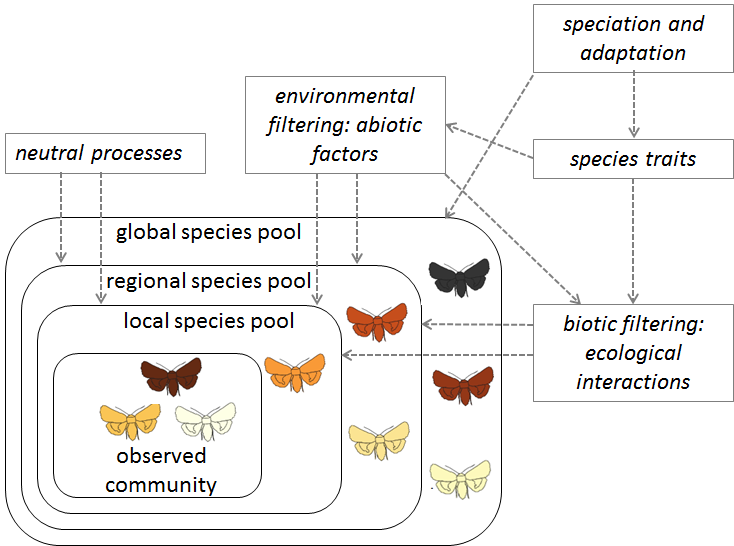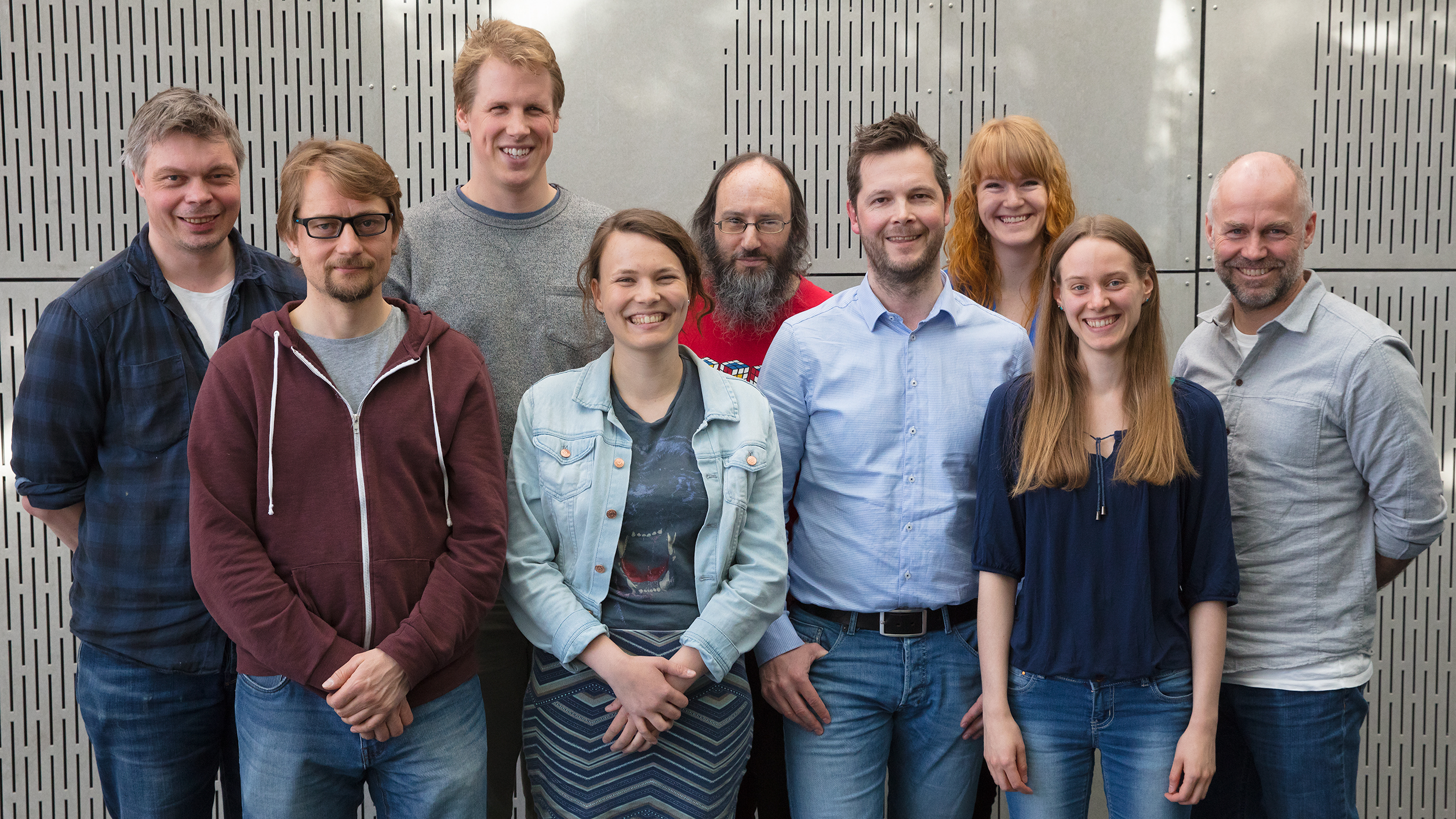Community Dynamics
Community Dynamics
 Spatial and temporal fluctuations in community structure may be due to dispersal, variation in environmental conditions, ecological heterogeneity among species, interspecific interactions and demographic stochasticity. The research group aim to estimate the relative contribution from these factors in shaping species abundance distributions and in causing spatio-temporal variation in community composition. The group has a large emphasis on developing methods leading to improved estimates from community data.
Spatial and temporal fluctuations in community structure may be due to dispersal, variation in environmental conditions, ecological heterogeneity among species, interspecific interactions and demographic stochasticity. The research group aim to estimate the relative contribution from these factors in shaping species abundance distributions and in causing spatio-temporal variation in community composition. The group has a large emphasis on developing methods leading to improved estimates from community data.
News
The paper “How are species interactions structured in species rich communities? A new method for analysing time-series data" by Ovaskainen, Tikhonov, Dunson, Grøtan, Engen, Sæther and Abrego has been accepted for publication in Proc. Roy. Soc. B.

Who are we?
Vidar Grøtan. Associate professor at Department of Biology. Current research involves statistical analysis of community dynamics and population dynamics with emphasis on effects of environmental fluctuations.
Otso Ovaskainen. Professor at the University of Helsinki and visiting professor at CBD. Current research involves the development statistical methods for community ecology, in particular joint species distribution models.
Bob O'Hara. Professor in the Department of Mathematical Sciences. Currently mainly working on modelling the distribution and dynamics of species, using a variety of data sources. He also gets himself involved in other projects, ranging from flying cranes to Finnish faces.
Anders Gravbrøt Finstad. Associate professor at Department of Natural History. Current research involves community dynamics, population dynamics and resulting species distribution of freshwater organisms, particularly fish populations, with emphasis on cumulative effects of anthropogenic and natural induced environmental fluctuations.
Ola Diserud. Senior research scientist at Norwegian Institute for Nature Research (NINA) and adjunct associate professor at Department of Mathematical Sciences. Monitoring communities’ response to changes in the environment is an important part in many projects for nature management authorities. This includes the use of eDNA to describe community composition in aquatic systems, use of paleolimnological sediment samples as references and analyses of how heterogeneity in species dynamics affect community dynamics.
Sam Perrin. Sam completed his MSc at the University of Bremen, Germany, writing his thesis on exchange at the CBD in 2016. Sam completed his BSc at the University of Melbourne. Having grown up in Australia, Sam has a keen interest in mitigating the effects of invasive species on native communities.
Caitlin Mandeville. Caitlin is a PhD student working jointly at the Department of Natural History and the Centre for Biodiversity Dynamics. Together with the interdisciplinary Transforming Citizen Science for Biodiversity team, she is investigating effective applications of citizen science datasets to ecological research.
PhD and Master projects
Current:
Sam Perrin: Consequences of freshwater connectivity on fish communities in the face of climate change and invasive species.
Tanja Petersen: Sustaining biodiversity and ecosystem services in urban areas under changing land use and climate pressures
Lisa Sandal: Spatiotemporal dynamics of avian communities
Previous:
Emma-Liina Marjakangas: Consequences of land use change in ecosystem functioning in Brazilian Atlantic forest
Eirik Blystad Solbu: Modelling and statistical analysis of demographic and environmental changes in populations and communities
Selected publications
Ovaskainen, O., Tikhonov, G., Norberg, A., Blanchet, F.G., Duan, L., Dunson, D., Roslin, T. and Abrego, N. 2017. How to make more out of community data? A conceptual framework and its implementation as models and software. Ecology Letters 20, 561-576.
Ovaskainen, O., Abrego, N., Halme, P. and Dunson, D. 2016. Using latent variable models to identify large networks of species-to-species associations at different spatial scales. Methods in Ecology and Evolution 7, 549–555.
Ovaskainen, O., D. B. Roy, R. Fox, and B. J. Anderson. 2016b. Uncovering hidden spatial structure in species communities with spatially explicit joint species distribution models. Methods in Ecology and Evolution 7:428-436.
Bellier, E., Grøtan, V., Engen, S., Schartau, A.-K., Herfindal, I. & Finstad, A.G. 2014. Distance decay of similarity, effects of environmental noise and ecological heterogeneity among species in the spatio-temporal dynamics of a dispersal-limited community. Ecography 37, 172–182
Grøtan, V., Lande, R., Chacon, I.A. and DeVries, P.J. 2014. Seasonal cycles of diversity and similarity in a Central American rainforest butterfly community. Ecography 37, 509–516
Hansen, B. B., V. Grøtan, R. Aanes, B. E. Sæther, A. Stien, E. Fuglei, R. A. Ims, N. G. Yoccoz, and A. O. Pedersen. 2013. Climate Events Synchronize the Dynamics of a Resident Vertebrate Community in the High Arctic. Science 339:313-315.
Sæther, B. E., S. Engen, and V. Grøtan. 2013. Species diversity and community similarity in fluctuating environments: parametric approaches using species abundance distributions. Journal of Animal Ecology 82:721-73
